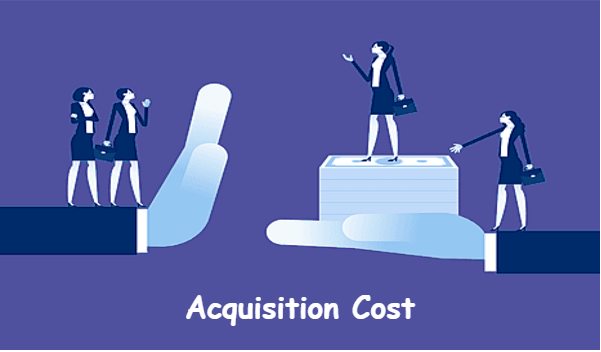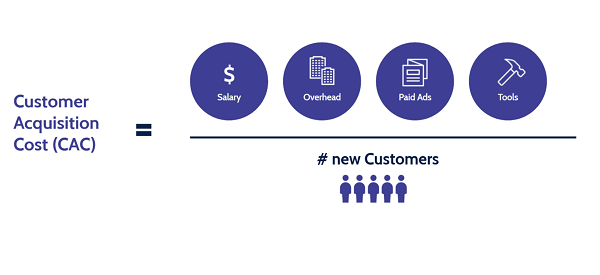Acquisition Cost: What is it in Business Accounting?Accurate financial reporting and decision-making in the field of business accounting depend solely on the grasp of the acquisition cost concept. The overall costs incurred by a business when buying an asset or making an investment for acquiring a new client are referred to as acquisition costs. It includes all the expenses related to acquiring or manufacturing an asset, using it, and preparing it for its intended use. Due to its direct impact on asset valuation, depreciation, and profitability calculations, the acquisition cost is of utmost significance. 
The purchase price, transaction fees, transportation costs, installation costs, and any other expenditure that may be directly linked to the cost are all some of the components that make up acquisition costs. It includes both the initial cash outlay and any non-monetary payments made in exchange for an asset, like the issuance of stock or the assumption of debt. Businesses may accurately calculate the true worth of their assets on the balance sheet and give a clear picture of their financial position by taking into account all pertinent charges. For many financial evaluations and decision-making processes, it is essential to accurately calculate the purchase cost. It has an impact on how depreciation, which is spread across the asset's useful life, is calculated. Depreciation costs increase over time in direct proportion to the acquisition cost. Furthermore, the acquisition cost is very important in determining a specific asset or investment's return on investment (ROI) and profitability before it is acquired. Acquisition Cost in Different SectorsWhen corporations participate in the acquisition of assets, enterprises, or strategic investments, acquisition costs play a significant role in several aspects of the economy. To ensure informed decision-making and financial evaluation, it is important to carefully analyze acquisition costs given the variety of sectors, each with its own distinctive set of characteristics, market sentiments, and dynamics. Accurately estimating the associated costs and possible synergies requires understanding the dynamics and complexities unique to each sector. Companies may take well-versed verdicts, distribute resources effectively, and optimize the value gained from acquisitions by managing acquisition expenses effectively. Businesses can improve their strategic growth plans and successfully manage the complexities of their industry by properly reviewing and accounting for acquisition expenses. This will ultimately contribute to long-term success and sustainable business growth. As already said, the expenditures incurred by firms when acquiring assets, enterprises, or making significant investments are referred to as acquisition costs. These expenses play a crucial role in calculating the financial effects and assessing the viability of an acquisition. Acquisition expenses take on many shapes and relevance in industries like manufacturing, real estate, technology, healthcare, retail, financial services, energy, telecommunications, pharmaceuticals, hospitality, automotive, and media and entertainment. Healthcare SectorIn this industry, acquisition costs consist of the costs related to purchasing medical facilities and equipment. The supply of medical services, including hospitals, clinics, prescription drugs, and medical equipment, is usually included in the healthcare sector. Manufacturing SectorGoods are produced in the manufacturing industry using a range of procedures, techniques, and methods. In this industry, acquisition costs are the typical expenditures spent when businesses buy machinery, equipment, or technology to improve their capacity for production. Real-estate SectorThe real estate industry is concerned with acquiring, resale, and constructing real estate. The expenditures related to purchasing properties, such as the purchase price, transaction fees, legal charges, and other directly attributable costs, are referred to as acquisition costs in this industry. Technology SectorThe creation, production, and distribution of tech-related goods and services are the main objectives of this industry. In this industry, acquisition costs refer to the expenditures incurred when businesses buy rival software companies directly and/ or indirectly to acquire a huge customer base. Patents, intellectual property rights, software licenses, or other technological assets are also included in the acquisition cost of this sector. Retail SectorDirect sales of products or services to customers through physical storefronts or online marketplaces comprise the retail sector. In this industry, acquisition costs are the fees spent when businesses buy other retail chains or individual stores to increase their market share and gain more direct access to customers. Financial SectorActivities associated with banking, investing, insurance, and other financial services are included in the financial sector. In this industry, acquisition costs are expenditures related to purchasing other financial institutions or investment portfolios. Energy SectorThe energy sector deals with the production, distribution, and use of energy resources, such as oil, gas, electricity, and renewable energy. This sector's acquisition costs include the expenditures incurred by businesses when they purchase oil and gas reserves, renewable energy projects, or power generation facilities. Telecommunications SectorInformation and communication are transmitted over a variety of channels, including wireless networks, the Internet, and telephones, in the telecommunications industry. The expenditures paid when businesses buy other telecommunications providers, spectrum licenses, or infrastructure assets are referred to as acquisition costs in this industry. Pharmaceutical SectorThe pharmaceutical sector's main objectives are the research, development, production, and distribution of pharmaceutical drugs and therapies. In this industry, acquisition costs include the costs related to purchasing other pharmaceutical companies, drug patents, or research and development facilities. Hospitality SectorThe hospitality sector includes businesses like hotels, restaurants, and resorts that offer customers lodging, food, and beverage services. In this industry, acquisition costs refer to the costs spent when businesses purchase hotels, resorts, or established restaurant chains. Automotive SectorThe automotive industry is responsible for producing, marketing, and retailing motor vehicles, such as cars, motorcycles, and commercial trucks. In this industry, acquisition costs are the fees spent when businesses buy other automakers or assets in order to diversify their product offerings or increase their market presence. Media and Entertainment SectorFilm, television, music, publishing, and digital media are all included in the media and entertainment sector, which is comprised of businesses engaged in creating, producing, and distributing content. In this industry, acquisition costs consist of the costs related to buying film studios, television networks, record labels, or digital content platforms. When firms acquire assets, businesses, or strategic investments, acquisition costs are paid in each of these industries. Depending on the sector's minute details, these expenditures may include purchase prices, transaction fees, legal charges, fees for doing due diligence, and other costs that can be clearly linked to the acquisition. Customer Acquisition CostA key indicator used by companies to assess the efficacy and efficiency of their marketing and sales efforts is customer acquisition cost (CAC). It indicates the overall expense incurred by a business to bring in a new client. Because it enables organizations to allocate resources accurately and optimize marketing budgets, CAC is a crucial indicator for understanding the financial impact of customer acquisition techniques. In order to calculate CAC, you must add up all of the expenses related to bringing on new clients within a given time frame and divide that total by the number of clients you brought on. Typically, the expenses taken into account in the computation include those for marketing and advertising, the salary and commissions of the sales team, and software and technology. Additionally, if they are directly connected to efforts to acquire customers, other costs, such as research and development costs for product creation, consumer research, and market analysis, can also be included. To obtain an accurate CAC measurement, it is essential to include all pertinent costs. Importance of Managing CAC
It is important to remember that CAC should not be evaluated in isolation but as one component of a comprehensive and in-depth study that typically considers all critical indicators such as customer happiness, retention rates and overall business profitability. Companies can acquire a more comprehensive knowledge of their customer acquisition activities and make wise decisions to promote sustainable growth by including these extra indicators. The Formula for Customer Acquisition Cost (CAC) and Components of CACThe following equation can be used to determine customer acquisition cost (CAC): Customer Acquisition Cost (CAC) = Total Marketing and Sales Costs / Number of Customers Acquired 
Components of Customer Acquisition Cost CAC
The CAC calculates the average cost to acquire each new client by dividing the entire marketing and sales expenses by the total number of consumers acquired from that particular acquisition strategy, operation, or campaign. Although the calculation seems simple, it's crucial to remember that it might be difficult to precisely calculate and assign costs to customer acquisition. Businesses must make sure they record all pertinent costs and properly allocate them to initiatives to bring in new customers. To acquire an accurate picture of CAC, rigorous monitoring and analysis of numerous cost categories are necessary. ExamplesExample 1: Let's say a company spent Rupees 5,00,000 on marketing and sales efforts in a month. During that same month, they acquired 500 new customers. To calculate the CAC, divide the total marketing and sales costs by the number of customers acquired: CAC = Rupees 5,00,000 / 500 = Rupees 1000 In this example, the CAC is Rupees 1000, which means that, on average, the company spent Rupees 1000 to acquire each new customer during that month. Example 2: Let's consider a software-as-a-service (SaaS) company. They allocated Rupees 150,000 for marketing and sales efforts in a quarter, and within that period, they successfully acquired 300 new customers. The calculation would be as follows: CAC = Rupees 150,000 / 300 = Rupees 500 Here, the CAC is Rupees 500, indicating that, on average, the company spent Rupees 500 to acquire each new customer during that quarter. These illustrations show how the CAC can change based on marketing and sales expenses as well as the volume of new clients. Businesses should regularly analyze and monitor CAC in order to spot trends, assess the effectiveness of client acquisition techniques, and make wise decisions about budget allocation, marketing tactics, and acquisition costs. |
 For Videos Join Our Youtube Channel: Join Now
For Videos Join Our Youtube Channel: Join Now
Feedback
- Send your Feedback to [email protected]
Help Others, Please Share









